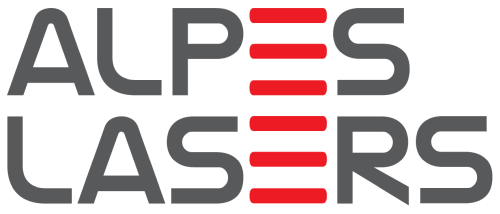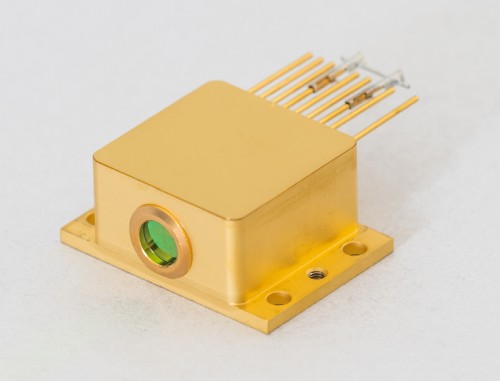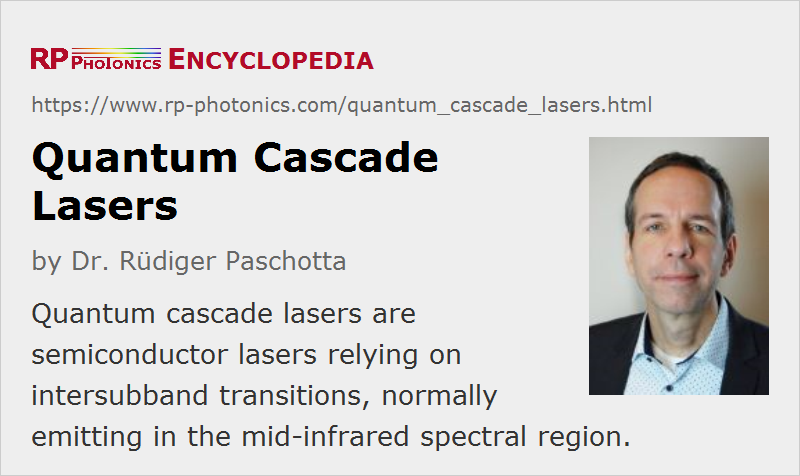Quantum Cascade Lasers
Acronym: QCL
Definition: semiconductor lasers relying on intersubband transitions, normally emitting in the mid-infrared spectral region
More general terms: semiconductor lasers, mid-infrared laser sources, terahertz sources
German: Quantenkaskadenlaser
Categories:  optoelectronics,
optoelectronics,  laser devices and laser physics
laser devices and laser physics
Author: Dr. Rüdiger Paschotta
Cite the article using its DOI: https://doi.org/10.61835/cc0
Get citation code: Endnote (RIS) BibTex plain textHTML
The quantum cascade laser is a special kind of semiconductor laser, usually emitting mid-infrared light. Such a laser operates on laser transitions not between different electronic bands but on intersubband transitions of a semiconductor structure. Figure 1 shows what happens to an electron injected into the gain region: in each period of the structure, it undergoes a first transition (blue arrow) between two sublevels (minibands) of a quantum well (which is the laser transition on which stimulated emission occurs), then a non-radiative transition (red arrow) to the lowest sublevel, before tunneling (gray arrow) into the upper level of the next quantum well. By using several tens or even 100 quantum wells in a series (a cascade), a higher optical gain and multiple photons per electron are obtained at the expense of a higher required electrical voltage. The operation voltage can easily be of the order of 10 V, whereas few volts are sufficient for ordinary laser diodes.

The diagram shows the electron energy versus position in the structure, which contains three quantum wells. The overall downward trend of energy towards the right-hand side is caused by an applied electric field. In reality, each gain region must be divided into an active region and an injector.
As the transition energies are defined not by fixed material properties but rather by design parameters (particularly by layer thickness values of quantum wells), quantum cascade lasers can be designed for operating wavelengths ranging from a few microns to well above 10 μm, or even in the terahertz region. Note that a single injected carrier can generate (in the ideal case of perfect quantum efficiency) one photon for each quantum well region.
In a quantum cascade laser, the mentioned quantum well structure is embedded in a waveguide, and the laser resonator is mostly of DBR or DFB type. There are also external-cavity lasers, where a wavelength tuning element such as a diffraction grating is part of the resonator.
Typical Properties of Quantum Cascade Lasers
Output Wavelengths
Most quantum cascade lasers emit mid-infrared light (which means wavelengths between 3 μm and 50 μm according to ISO 20473:2007) – they are thus a kind of mid-infrared laser sources. However, quantum cascade lasers can also be made for generating terahertz waves (→ terahertz sources). Such devices constitute particularly compact and simple (electrically pumped) sources of terahertz radiation. Even room temperature terahertz generation can been achieved via internal difference frequency generation [12].
Output Power and Efficiency
Whereas continuously operating room-temperature devices [4] are normally limited to moderate output power levels in the milliwatt region (although more than a watt is possible), multiple watts are easily possible with liquid-nitrogen cooling. Even at room temperature, watt-level peak powers are possible when using short pump pulses.
The power conversion efficiency of quantum cascade lasers is typically of the order of a few tens of percent. Recently, however, devices with efficiencies around 50% have been demonstrated [10, 11], although only for cryogenic operation conditions.
Dynamic Properties
The carrier lifetime in quantum cascade lasers is much shorter than in ordinary laser diodes, for example; it is limited by phonon scattering phenomena. That also has consequences for the dynamic properties: there is very strong damping of relaxation oscillations (overdamped transient dynamics). For that reason, quantum cascade lasers can be modulated with very high intrinsic bandwidth limited of several tens of gigahertz.
Linewidth
The emission linewidth is usually rather small – which is often very useful for applications in spectroscopy. A contributing factor for that is the small linewidth enhancement factor.
Applications of Quantum Cascade Lasers
Perhaps the most important applications for quantum cascade lasers will be in the area of laser absorption spectroscopy of trace gases, e.g. for detecting very small concentrations of pollutants in air. In addition to the suitable wavelength range, QCLs usually feature a relatively narrow linewidth and good wavelength tunability, making them very suitable for such applications.
Terahertz quantum cascade lasers are also interesting for various imaging applications. See the article on terahertz radiation.
Another application field of THz QCLs is free-space communications. Although terahertz beams exhibit substantially stronger beam divergence than optical beams, one can still use directed beams for short-distance transmission through air.
An example for a military application is the use for infrared countermeasures, i.e., irritating heat-seeking missiles attacking airplanes by sending mid-infrared light to their sensors.
More to Learn
Encyclopedia articles:
Suppliers
The RP Photonics Buyer's Guide contains 32 suppliers for quantum cascade lasers. Among them:


Alpes Lasers
Alpes Lasers designs and manufactures a wide range of QCLs with wavelengths from 4 to 14 μm and powers up to hundreds of milliwatts. This includes FP, DFB, THz, frequency comb and external cavity lasers in the mid-IR. Additionally, Alpes offers uniquely fast and widely tuneable lasers with our ET and XT product line.


Sacher Lasertechnik
Sacher Lasertechnik offers quantum cascade lasers with emission between 4 μm and 12 μm, suitable for applications like molecular spectroscopy.


Frankfurt Laser Company
Frankfurt Laser Company offers quantum cascade laser diodes with emission wavelengths from 4 μm to 13 μm with either DFB or Fabry–Pérot type.


DRS Daylight Solutions
DRS Daylight Solutions offers a wide range of quantum cascade lasers:
- The MIRcat-QT™ is a very rapidly wavelength-tunable version with up to 30,000 cm−1/s, covering wavelengths beyond 13 μm.
- The Hedgehog™ models are wavelength-tunable laser for mid-IR spectroscopy with up to 0.5 W average power and 1 W peak power. Ultra-quiet, superior wavelength repeatability.
- The CW-MHF™ is the ultimate tool for high-resolution, mid-IR spectroscopy with high spectral resolution and phase-continuous tuning to avoid jumping over spectral lines.
- The Aries-2 series is a family of fixed-wavelength, narrowband mid-IR lasers with an average output power of up to 1 W.
- The H-Model mid-IR laser offers high-power, mid-IR OEM laser performance in a compact footprint. CW and pulsed operation are possible.
- We also have high-power multi-color laser systems (VIS, NIR, SWIR, MWIR, and LWIR) with best-in-class performance for aircraft protection.


RPMC Lasers
Serving North America, RPMC Lasers offers a range of high-performance quantum cascade lasers. The PowerMir line emits in the main transmission bands of the atmosphere (4.0 µm, 4.6 µm, 4.8 µm, 9.x µm). Furthermore, the new line of UniMir Distributed Feedback (DFB) QCLs emit in the LWIR spectral region (11.3, 13.4 & 14 µm). The PowerMir line are Fabry-Perot laser sources operating in the quasi CW regime. In other words, pulsed operation down to few tens of nanoseconds and high frequency above MHz at room temperature. The UniMir line are DFB sources with CW operation. These products exhibit high average power and wall-plug efficiency. Therefore, perfect for counter-measure and other defense applications, as well as gas detection in the nuclear and petrochemical industries.
Bibliography
| [1] | R. F. Kazarinov et al., “Possibility of amplification of electromagnetic waves in a semiconductor with a superlattice”, Fiz. Tekh. Poluprovod. 5 (4), 797 (1971) |
| [2] | J. Faist et al., “Quantum cascade laser”, Science 264, 553 (1994); https://doi.org/10.1126/science.264.5158.553 |
| [3] | R. M. Williams et al., “Kilohertz linewidth from frequency-stabilized mid-infrared quantum cascade lasers”, Opt. Lett. 24 (24), 1844 (1999); https://doi.org/10.1364/OL.24.001844 |
| [4] | M. Beck et al., “Continuous wave operation of a mid-infrared semiconductor laser at room temperature”, Science 295, 301 (2002); https://doi.org/10.1126/science.1066408 |
| [5] | R. Köhler et al., “Terahertz semiconductor-heterostructure laser”, Nature 417, 156 (2002); https://doi.org/10.1038/417156a |
| [6] | B. S. Williams et al., “Operation of terahertz quantum-cascade lasers at 164 K in pulsed mode and at 117 K in continuous-wave mode”, Opt. Express 13 (9), 3331 (2005); https://doi.org/10.1364/OPEX.13.003331 |
| [7] | B. S. Williams, “Terahertz quantum-cascade lasers”, Nature Photon. 1, 517 (2007); https://doi.org/10.1038/nphoton.2007.166 |
| [8] | A. Kosterev et al., “Application of quantum cascade lasers to trace gas analysis”, Appl. Phys. B 90, 165 (2008); https://doi.org/10.1007/s00340-007-2846-9 |
| [9] | R. P. Green et al., “Linewidth enhancement factor of terahertz quantum cascade lasers”, Appl. Phys. Lett. 92 (7), 071106 (2008); https://doi.org/10.1063/1.2883950 |
| [10] | P. Q. Liu et al., “Highly power-efficient quantum cascade lasers”, Nature Photon. 4, 95 (2010); https://doi.org/10.1038/nphoton.2009.262 |
| [11] | Y. Bai et al., “Quantum cascade lasers that emit more light than heat”, Nature Photon. 4, 99 (2010); https://doi.org/10.1038/nphoton.2009.263 |
| [12] | M. A. Belkin et al., “Room temperature terahertz quantum cascade laser source based on intracavity difference-frequency generation”, Appl. Phys. Lett. 92 (20), 201101 (2008); https://doi.org/10.1063/1.2919051 |
| [13] | G. Scalari et al., “THz and sub-THz quantum cascade lasers”, Laser & Photon. Rev. 3 (1-2), 45 (2009); https://doi.org/10.1002/lpor.200810030 |
| [14] | F. Capasso, “High-performance midinfrared quantum cascade lasers” (review article, open access), Opt. Eng. 49 (11), 111102 (2010); https://doi.org/10.1117/1.3505844 |
| [15] | S. Kumar, “Recent progress in terahertz quantum cascade lasers”, J. Sel. Top. Quantum Electron. 17 (1), 38 (2011); https://doi.org/10.1109/JSTQE.2010.2049735 |
| [16] | C. Sirtori, “Wave engineering with THz quantum cascade lasers”, Nature Photon. 7, 691 (2013); https://doi.org/10.1038/nphoton.2013.208 |
| [17] | M. S. Vitiello et al., “Quantum cascade lasers: 20 years of challenges”, Opt. Express 23 (4), 5167 (2015); https://doi.org/10.1364/OE.23.005167 |
| [18] | M. Beiser et al., “Engineering the spectral bandwidth of quantum cascade laser frequency combs”, Opt. Lett. 46 (14), 3416 (2021); https://doi.org/10.1364/OL.424164 |
| [19] | A. Khalatpour et al., “High-power portable terahertz laser systems”, Nature Photonics 15, 16 (2021); https://doi.org/10.1038/s41566-020-00707-5 |
| [20] | Yu Wu et al., “Tunable quantum-cascade VECSEL operating at 1.9 THz”, Opt. Express 29 (21), 34695 (2021); https://doi.org/10.1364/OE.438636 |
| [21] | P. Täschler et al., “Femtosecond pulses from a mid-infrared quantum cascade laser”, Nature Photonics 15, 919 (2021); https://doi.org/10.1038/s41566-021-00894-9 |
Questions and Comments from Users
2021-04-08
How does a multiple quantum well laser differ from a quantum cascade laser?
The author's answer:
Although both types of devices contain a sequence of thin layers of different semiconductor materials, they have very different principles of operation:
- In a multiple quantum well laser, the quantum wells do not substantially interact with each other. They may not even be electrically pumped. It is just that each one contributes some amount to the gain. Also, one uses optical transitions between conduction and valence bands.
- In a quantum cascade laser, the quantum wells are much closer to each other, so that carriers can tunnel from one well to the next one. Also, one uses intersubband transitions, which typically exhibit much longer wavelengths.
Here you can submit questions and comments. As far as they get accepted by the author, they will appear above this paragraph together with the author’s answer. The author will decide on acceptance based on certain criteria. Essentially, the issue must be of sufficiently broad interest.
Please do not enter personal data here; we would otherwise delete it soon. (See also our privacy declaration.) If you wish to receive personal feedback or consultancy from the author, please contact him, e.g. via e-mail.
By submitting the information, you give your consent to the potential publication of your inputs on our website according to our rules. (If you later retract your consent, we will delete those inputs.) As your inputs are first reviewed by the author, they may be published with some delay.




2021-01-21
Why is the injection region needed in addition to the active region in a quantum cascade laser?
The author's answer:
The function of the quantum wells is vital for the operation of such a laser. That means they definitely need to be embedded into regions with higher electron energy; without those regions, you would not have any quantum wells and there's an entirely different electronic structure. Therefore, the only way is to use tunneling for the injection of carriers from one quantum well into the other.